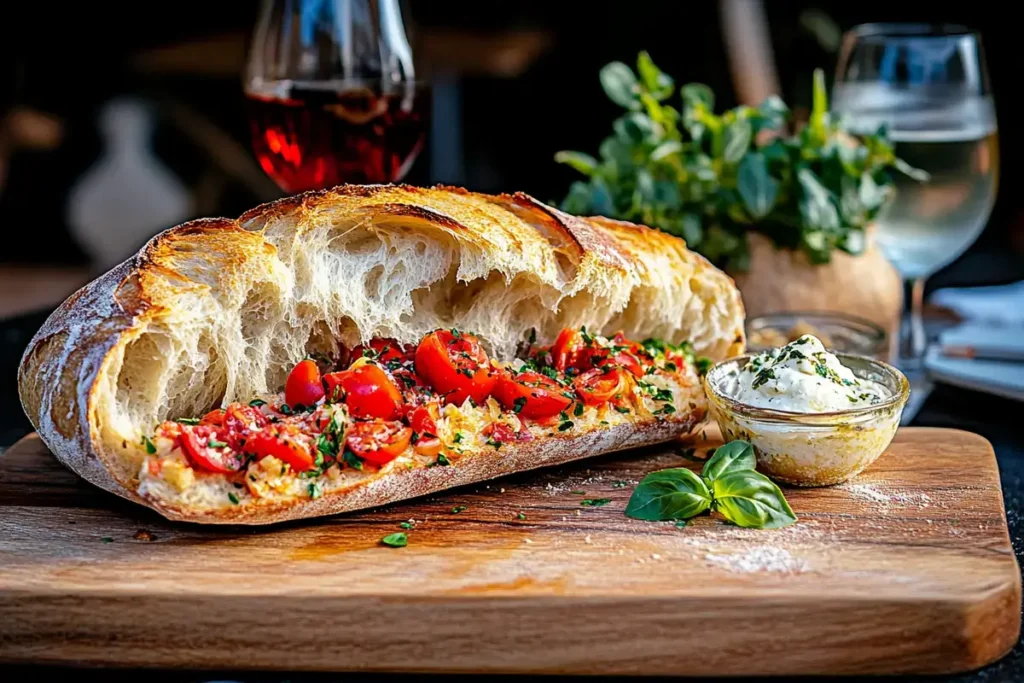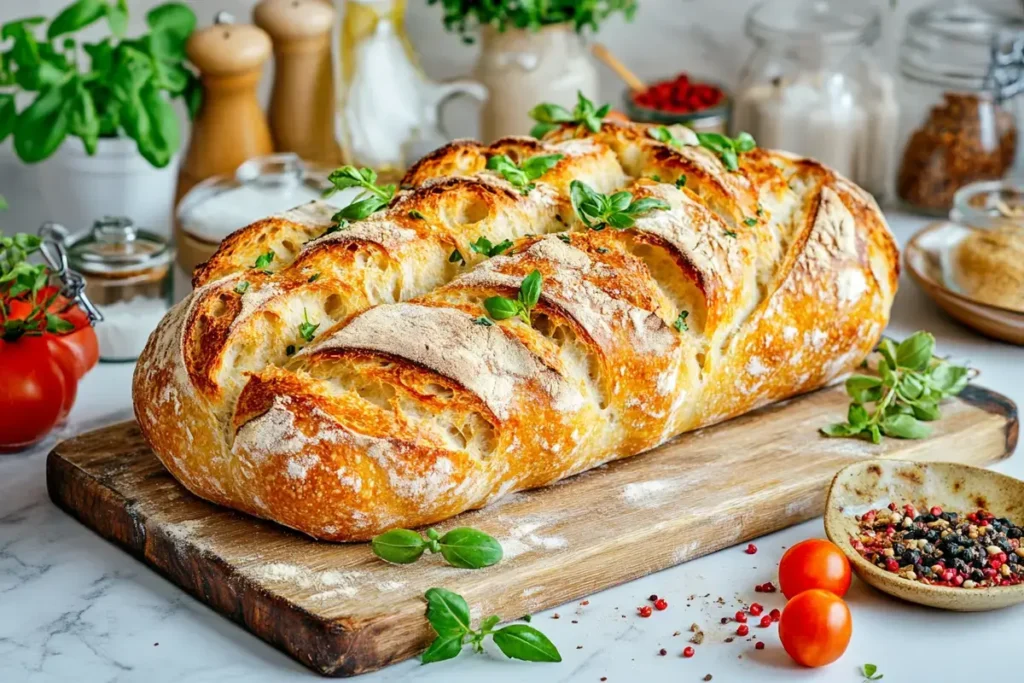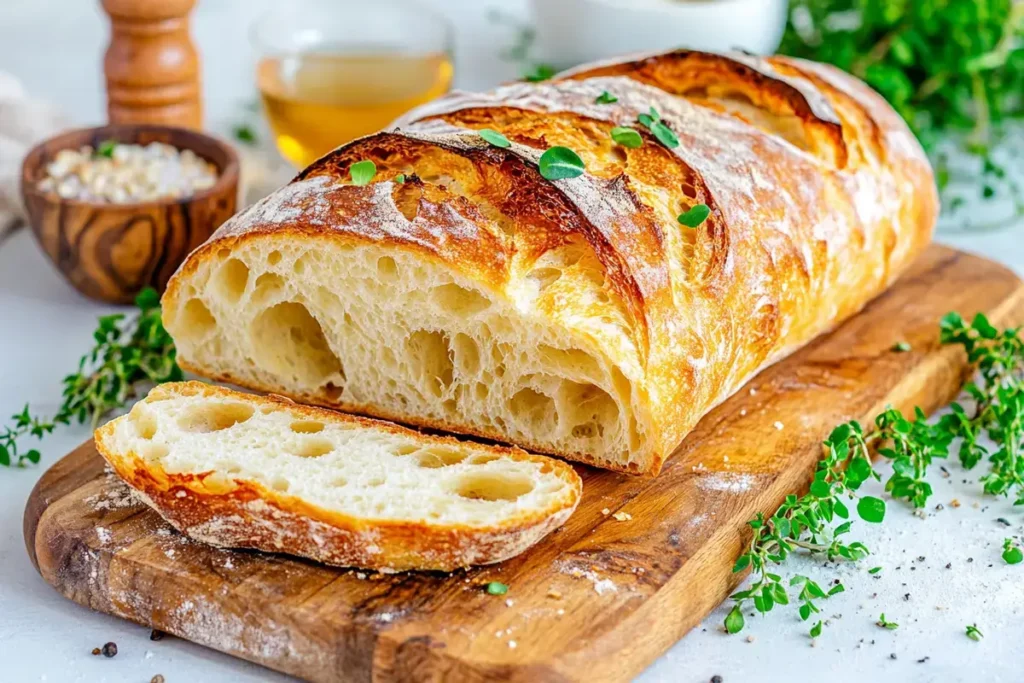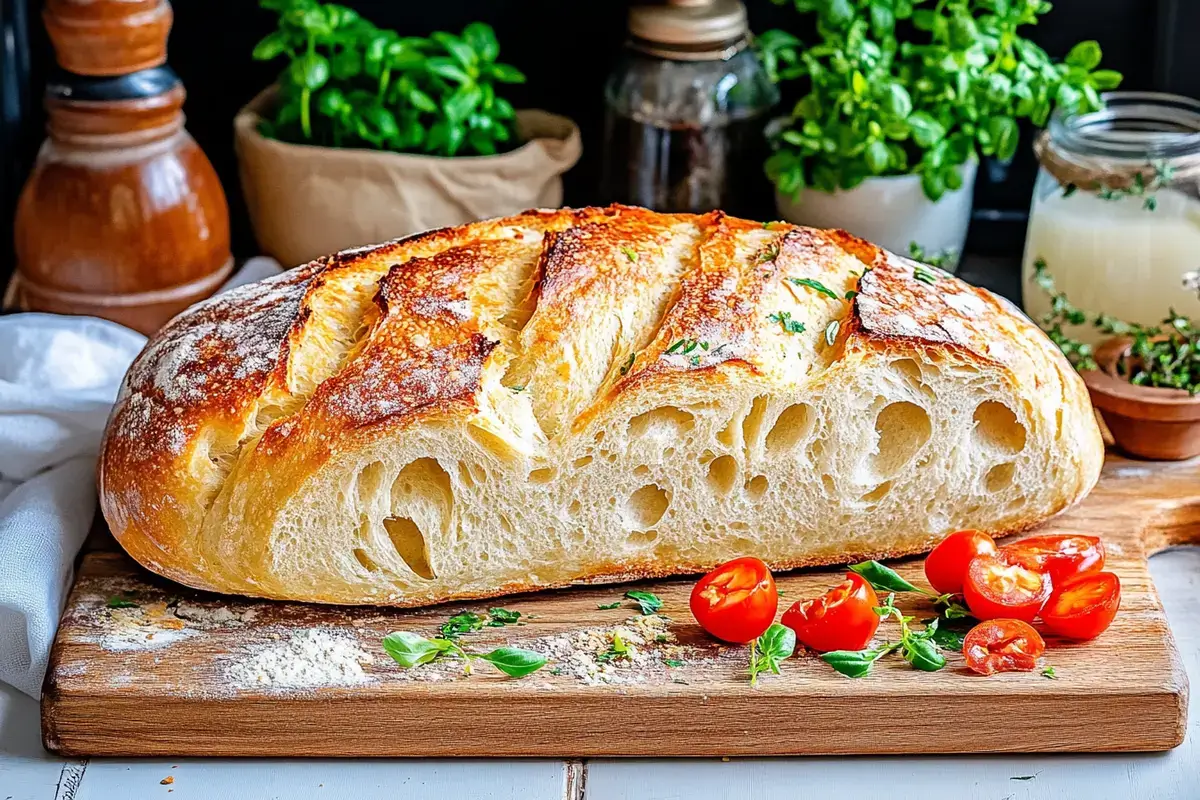Is ciabatta gluten free? This question arises often among bread lovers and health-conscious eaters.
Ciabatta is a rustic Italian bread known for its airy, open crumb and delightfully crispy crust. Many people appreciate ciabatta’s appealing texture and simple ingredient list. However, if you are following a gluten-free diet or suspect gluten intolerance, you may wonder whether ciabatta fits your lifestyle.
In this comprehensive guide, we’ll explore ciabatta’s origins, ingredients, and traditional preparation methods. We’ll address the challenges of gluten intolerance, the science behind gluten-free flours, and techniques for baking delicious gluten-free ciabatta. Plus, we’ll take a look at the taste, texture, and potential pitfalls of gluten-free alternatives. By the end of this article, you’ll have a thorough understanding of whether ciabatta suits your dietary needs and how to enjoy bread without compromising your health.
The Origin of Ciabatta Bread
Ciabatta is a relatively modern Italian bread. It originated in the early 1980s in the Veneto region of Italy. Its name means “slipper,” which describes its flattened oval shape. Despite its newer status in the grand timeline of breadmaking, ciabatta became a global phenomenon. Its crusty exterior and large, irregular holes inside are reminiscent of artisanal European loaves.
Italian bakers crafted ciabatta to compete with the popular French baguette. They wanted a distinctive bread with a chewy interior and crisp crust. Ciabatta uses high-hydration dough, which yields a soft, porous crumb. This characteristic crumb structure is key to its unique flavor and texture.
Traditional Ingredients and Gluten Content
The standard ingredients for ciabatta are wheat flour, water, yeast, salt, and sometimes olive oil. Wheat flour is the main source of gluten. Gluten is the protein network that gives wheat breads their structure and elasticity.
When baking ciabatta, the dough is usually very wet. This high moisture content, combined with gluten from wheat flour, develops the bread’s open, holey interior. The dough requires careful handling because it’s sticky. However, that stickiness helps trap air bubbles and creates the classic ciabatta texture.
If you are wondering, “Is ciabatta gluten free?” the short answer is no—not in its traditional form. Standard wheat flour is rich in gluten, making classic ciabatta unsuitable for those with celiac disease or gluten intolerance. Yet, modern baking innovations have made gluten-free versions possible. We’ll explore that later in this article.
Why Gluten Matters?
Gluten is a naturally occurring protein in grains like wheat, barley, and rye. In bread dough, gluten strands stretch and interlock when you knead or fold it. This network traps gases from yeast fermentation, causing the dough to rise. The result is a light and airy loaf.
Without gluten, many traditional bread recipes collapse or remain dense. Some people find gluten beneficial in achieving the chewy, elastic mouthfeel that is characteristic of artisanal bread. Others suffer reactions to gluten or simply choose to avoid it for personal reasons.
Important Points About Gluten:
- Structure: Gluten forms a framework that helps dough hold its shape.
- Elasticity: Gluten allows bread to expand without tearing.
- Texture: A good gluten network yields a chewy, bouncy crumb.

Who Should Avoid Gluten?
Celiac disease is an autoimmune disorder triggered by gluten. People with celiac disease experience damage to the small intestine when they ingest gluten. Symptoms include diarrhea, bloating, fatigue, and malabsorption of nutrients.
Some individuals have non-celiac gluten sensitivity. This condition can cause symptoms like abdominal pain, headaches, or fatigue. While less severe than celiac disease, it still warrants caution about gluten intake.
Others avoid gluten by choice to reduce inflammation, manage weight, or follow a particular diet plan. Regardless of the reason, if you need or want to remove gluten from your meals, checking ingredients is essential.
Why Ciabatta Raises Questions?
Ciabatta’s airy crumb suggests a less “heavy” bread. However, the wheat-based recipe still contains a significant amount of gluten. Those with celiac disease or gluten sensitivity should approach ciabatta with care—or choose a verified gluten-free version.
Exploring Gluten-Free Alternatives
Fortunately, the baking world now offers many gluten-free options. Home bakers and professionals experiment with alternative flours and binding ingredients. These flours lack gluten but may still yield an enjoyable bread.
Common Gluten-Free Flours Include:
- Rice Flour: Mild in flavor and fine in texture.
- Tapioca Flour: Provides elasticity and chewiness.
- Potato Starch: Adds moisture and tenderness.
- Corn Flour: Offers sweetness and structure.
- Buckwheat Flour: Earthy taste, good for hearty breads.
- Sorghum Flour: Neutral flavor, often used in blends.
Breadmakers frequently combine these flours to mimic wheat flour’s baking performance. These blends may include xanthan gum or psyllium husk to replicate gluten’s binding qualities. Xanthan gum acts as a stabilizer, helping trap air bubbles. Psyllium husk forms a gel-like consistency that can improve dough elasticity.
Steps to Identify a Good Gluten-Free Bread:
- Check Labels: Always verify the ingredient list.
- Look for Binders: Xanthan gum or psyllium is often essential.
- Focus on Texture: A crumbly, dry texture may indicate poor formulation.
- Taste Test: Flavors differ by brand and flour mix.
How to Make Gluten-Free Ciabatta?
Creating gluten-free ciabatta at home requires patience, experimentation, and a suitable flour blend. Here’s a general strategy:
- Choose a Quality Gluten-Free Flour Mix
Select a blend containing rice flour, tapioca flour, and a binding agent. Some commercial mixes are designed specifically for bread baking. - Incorporate Yeast and Liquid
Hydration is crucial. High moisture helps form the large holes reminiscent of ciabatta. A wet dough is typical, so expect some stickiness. - Add Oil and Salt
Olive oil enriches the dough and provides flavor. Salt is essential for taste and for controlling yeast activity. - Use a Stand Mixer
Gluten-free dough is often too wet for hand-kneading. A mixer ensures thorough blending without overworking the dough. - Allow Proper Fermentation
Give the dough time to rise. Even though gluten-free breads might not double in size, gentle fermentation improves texture. - Shape Carefully
Traditional ciabatta has a slipper-like shape. Gently turn the risen dough onto a floured surface. Avoid aggressive handling, as there’s no gluten network to keep the dough together. - Bake with Steam
Introduce steam into the oven for a crisp crust. Place a tray of water below the baking rack or briefly spritz water on the oven walls. - Monitor Doneness
Use visual cues to see if the crust has turned golden brown. Tap the loaf’s underside for a hollow sound, indicating a thorough bake.
This process yields a gluten-free loaf that captures much of ciabatta’s essence. However, don’t expect an exact match to wheat-based bread. Gluten-free doughs often require trial and error before you find the perfect recipe.
Handling Sticky Dough:
Working with wet dough is tricky. Consider dusting your hands with additional gluten-free flour or use a silicone spatula to transfer the dough. Extra moisture leads to a more authentic ciabatta texture once baked.
Flavor and Texture Expectations
Gluten-free ciabatta can be light, airy, and delicious. However, you may notice subtle differences from the wheat-based version.
- Milder Flavor: Alternative flours often lack the natural nuttiness of wheat.
- Slightly Denser: Even with high hydration, it may not achieve the same openness in the crumb.
- Crust Variations: Some gluten-free flours crisp differently, so the crust could be more brittle.
- Chewiness: You’ll miss that stretchy chewiness from gluten, though binders can approximate it.
Despite these variations, a well-made gluten-free ciabatta can still be enjoyable. Pair it with olive oil, herbs, or cheese to enhance the taste. Toasting can also add texture and flavor complexity.

Potential Downsides of Gluten-Free Ciabatta
While gluten-free breads are crucial for those with celiac disease or sensitivities, they aren’t perfect. They often contain additives like xanthan gum or guar gum to replicate gluten’s structure. Some individuals may find these gums irritate their digestive systems.
Additionally, store-bought gluten-free breads can be more expensive than their wheat counterparts. They may contain refined starches that lack nutritional value. If you’re looking for a nutrient-dense option, consider whole-grain gluten-free flours like buckwheat or sorghum in your baking blend.
Mindful Consumption:
If you are new to gluten-free diets, check with a healthcare provider. They can guide you on potential dietary gaps. Proper meal planning ensures you get enough fiber, vitamins, and minerals. Balancing different gluten-free flours can help maintain a varied nutrient profile.
Health Benefits of a Gluten-Free Diet
Many people adopt a gluten-free diet out of medical necessity. Others choose it for potential wellness benefits. Here are some ways it may positively affect your health:
- Improved Digestive Comfort
Individuals with gluten intolerance often experience less bloating, gas, or stomach pain after removing gluten. Avoiding wheat-based breads can alleviate gastrointestinal symptoms, leading to greater comfort. - Reduced Inflammation
Some studies suggest that going gluten-free may decrease inflammatory responses in certain individuals. While not universally proven, people with autoimmune conditions sometimes report feeling better after cutting out gluten. - Enhanced Nutrient Awareness
Eliminating gluten forces you to read food labels more closely. This diligence can encourage healthier eating habits overall. You might discover new whole-food alternatives like quinoa, millet, or amaranth, which can diversify your diet. - Better Energy Levels
Persistent fatigue is a common complaint for people with undiagnosed celiac disease. Once gluten is removed, nutrient absorption often improves, potentially boosting energy.
Keep in mind that a gluten-free diet should be balanced. Replace wheat with nutrient-rich whole grains and proteins rather than relying on processed gluten-free snacks. Consulting a nutritionist can help ensure you meet your dietary needs.
Fun Ways to Serve Gluten-Free Ciabatta
Gluten-free ciabatta can be a versatile foundation for meals or snacks. Although it may differ slightly in texture, it still pairs beautifully with classic toppings:
- Brush with Olive Oil and Herbs
A drizzle of high-quality olive oil plus rosemary or thyme transforms your loaf into a savory appetizer. Lightly toast it to develop extra crispness. - Classic Italian Panini
Slice your gluten-free ciabatta horizontally and fill it with mozzarella, tomatoes, basil, and a dash of balsamic vinegar. Press or grill until the cheese melts. - Hearty Sandwiches
Use it for robust sandwiches loaded with chicken, fresh greens, and savory spreads. The airy crumb holds up surprisingly well to a variety of fillings. - Garlic Bread Twist
Mix softened butter with chopped garlic and parsley. Spread on your ciabatta slices before toasting in the oven. Enjoy a crispy, garlicky treat alongside pasta or soups. - Breakfast Boost
Top warm slices with avocado, a sprinkle of salt, and a squeeze of lemon. For more protein, add a poached egg and a pinch of pepper.
Experiment with flavors and textures. A well-baked gluten-free ciabatta provides a canvas for both sweet and savory combinations, making it an excellent choice for various cuisines.
Common Mistakes When Baking Gluten-Free Ciabatta
Even seasoned bakers can find gluten-free bread a challenge. Here are some frequent pitfalls and tips to avoid them:
- Not Using a Binder
Skipping binders like xanthan gum or psyllium husk often results in a crumbly loaf. These ingredients help trap air, giving bread a lighter structure. - Over-Mixing
Gluten-free dough doesn’t need extensive kneading. Over-mixing can lead to a dense, gummy texture. Mix just until ingredients are well combined, then stop. - Too Little Hydration
Gluten-free flours absorb a lot of liquid. If your dough is too dry, the bread will be dense and heavy. Aim for a sticky consistency that might feel unfamiliar at first but yields a better crumb. - Rushing the Rise
Yeast needs time to work, and gluten-free dough can take longer to rise. Be patient. Let the dough sit in a warm, draft-free area to develop flavor and air pockets. - High Oven Temperature Without Steam
While a hot oven is good for crust development, introducing steam can make the difference between a soft interior and a rock-hard crust. Always consider placing a small pan of water in the oven or lightly misting the walls before baking.
Avoiding these mistakes helps ensure you get a loaf closer to classic ciabatta in look and feel. A little practice goes a long way toward mastering the art of gluten-free baking.
Tips for Buying and Storing Bread
Whether you buy or bake your gluten-free ciabatta, proper storage is important. Gluten-free baked goods can dry out quickly due to the lack of gluten.
- Storage Container: Keep bread in an airtight container or wrap it in plastic.
- Refrigeration: Use the refrigerator only if you expect the bread to last more than a few days. Refrigeration can dry out bread, so weigh the pros and cons.
- Freezing: Slice the loaf before freezing. This way, you can thaw individual pieces when needed.
- Reviving Bread: Warm slices in a toaster or low-temperature oven to refresh the texture.
Because gluten-free bread lacks the natural preservation qualities of wheat’s gluten network, consider smaller batches. Freshness is key to enjoying the best flavor and texture.

FAQs
Is ciabatta bread ok for gluten intolerance?
Ciabatta made with regular wheat flour contains gluten. People with gluten intolerance should avoid traditional ciabatta. However, gluten-free ciabatta options or recipes use alternative flours. Always check labels or ask about ingredients when purchasing.
What bread is gluten-free?
Gluten-free bread is typically made from alternative flours like rice, tapioca, sorghum, or buckwheat. These breads use binders (xanthan gum or psyllium husk) instead of gluten. You can find packaged gluten-free loaves in many grocery stores or bake your own at home using certified gluten-free ingredients.
Can you make ciabatta with gluten-free flour?
Yes, it’s possible to make ciabatta with gluten-free flour. You’ll need a suitable blend of alternative flours, binders, and a higher water ratio to mimic the airy structure of traditional ciabatta. Gluten-free versions often have a slightly denser crumb and less chewy texture but can still taste delicious.
Is ciabatta a wheat?
Traditional ciabatta is indeed a wheat-based bread, which means it contains gluten. Its soft interior and crispy crust rely on the gluten network in wheat flour. For those who cannot consume gluten, look for gluten-free ciabatta alternatives or try baking it at home with gluten-free ingredients.

